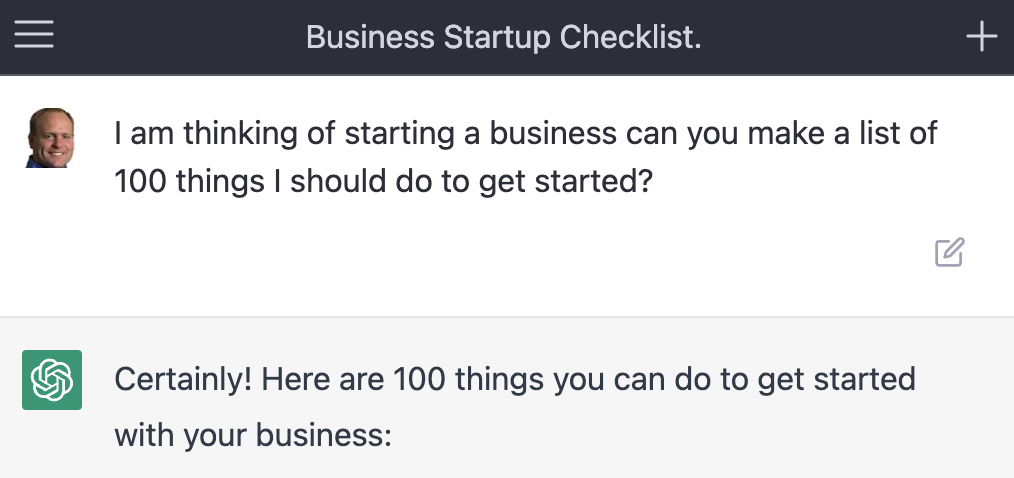While writing All Hail the CPA we were thinking about what small business owners really want. We were looking at all the advice that’s available for entrepreneurs on the Internet. ChatGPT made it all a lot simpler.
ChatGPT’s 100 Things an Entrepreneur Must Do
- Research your industry and competition.
- Identify a unique selling proposition (USP) for your business.
- Create a business plan.
- Determine your target market and create a customer profile.
- Determine your start-up costs and secure funding.
- Choose a business name.
- Register your business.
- Obtain necessary permits and licenses.
- Choose a legal structure for your business.
- Set up a business bank account.
- Hire a lawyer and accountant.
- Create a logo and brand identity.
- Develop a marketing strategy.
- Choose a location for your business.
- Set up a website.
- Develop a content marketing plan.
- Develop a social media strategy.
- Create a business email address.
- Develop a sales strategy.
- Create a pricing strategy.
- Develop a customer service strategy.
- Develop a product or service offering.
- Create a prototype.
- Conduct market research.
- Conduct a SWOT analysis.
- Develop a competitive analysis.
- Choose suppliers and vendors.
- Determine your inventory needs.
- Set up a supply chain.
- Create a sales forecast.
- Determine your breakeven point.
- Develop a cash flow projection.
- Set up a bookkeeping system.
- Choose a payment processor.
- Develop an invoicing system.
- Hire employees.
- Develop an employee handbook.
- Set up payroll.
- Develop a training program for employees.
- Establish an employee benefits package.
- Create job descriptions.
- Set up a performance evaluation system.
- Establish an employee recognition program.
- Develop a contingency plan.
- Determine key performance indicators (KPIs) for your business.
- Develop a data tracking system.
- Set up a system for reporting and analysis.
- Develop a crisis communication plan.
- Create a customer loyalty program.
- Set up a customer feedback system.
- Develop a referral program.
- Establish a customer acquisition plan.
- Create a customer retention plan.
- Develop a customer segmentation strategy.
- Choose a CRM system.
- Set up an email marketing system.
- Develop a lead generation plan.
- Set up a sales funnel.
- Develop a content creation plan.
- Establish a blog.
- Create a video marketing plan.
- Develop a podcast strategy.
- Choose a web hosting provider.
- Set up an SEO strategy.
- Develop a PPC advertising strategy.
- Create a PR plan.
- Set up a media kit.
- Develop a speaking strategy.
- Attend networking events.
- Join industry associations.
- Participate in online forums and groups.
- Host webinars.
- Create a YouTube channel.
- Develop a customer referral program.
- Set up an affiliate marketing program.
- Create an e-commerce store.
- Develop a shipping strategy.
- Set up a returns and refunds policy.
- Choose a packaging supplier.
- Develop a packaging design.
- Set up a product fulfillment system.
- Choose a payment gateway.
- Set up a fraud prevention system.
- Develop a customer support system.
- Choose a hosting provider for your website.
- Create a customer acquisition funnel.
- Set up a sales pipeline.
- Develop a content distribution plan.
- Establish a brand ambassador program.
- Create a press release strategy.
- Set up a customer segmentation system.
- Choose an email marketing automation tool.
- Develop a webinar strategy.
- Set up a podcast distribution system.
- Develop a referral marketing plan.
- Choose a video hosting platform.
- Set up an influencer marketing program.
- Develop a customer success plan.
- Choose a customer feedback tool.
- Continuously evaluate and adjust your business strategies to stay competitive and profitable.
We return to first principles.
Our Founding First Principles
- You have to exist. This means having a landing page.
- You have to have something to show. Could be a demo, could be a sales presentation.
- You have to talk to potential customers and eventually get one of them to buy something from you.
Everything else is superfluous, distracting advice probably from someone trying to sell you something.
— more to come —
Chapter 1: Introduction – There is a better way
Chapter 2: All Hail the CPA
Chapter 3: Making a business easier to run


